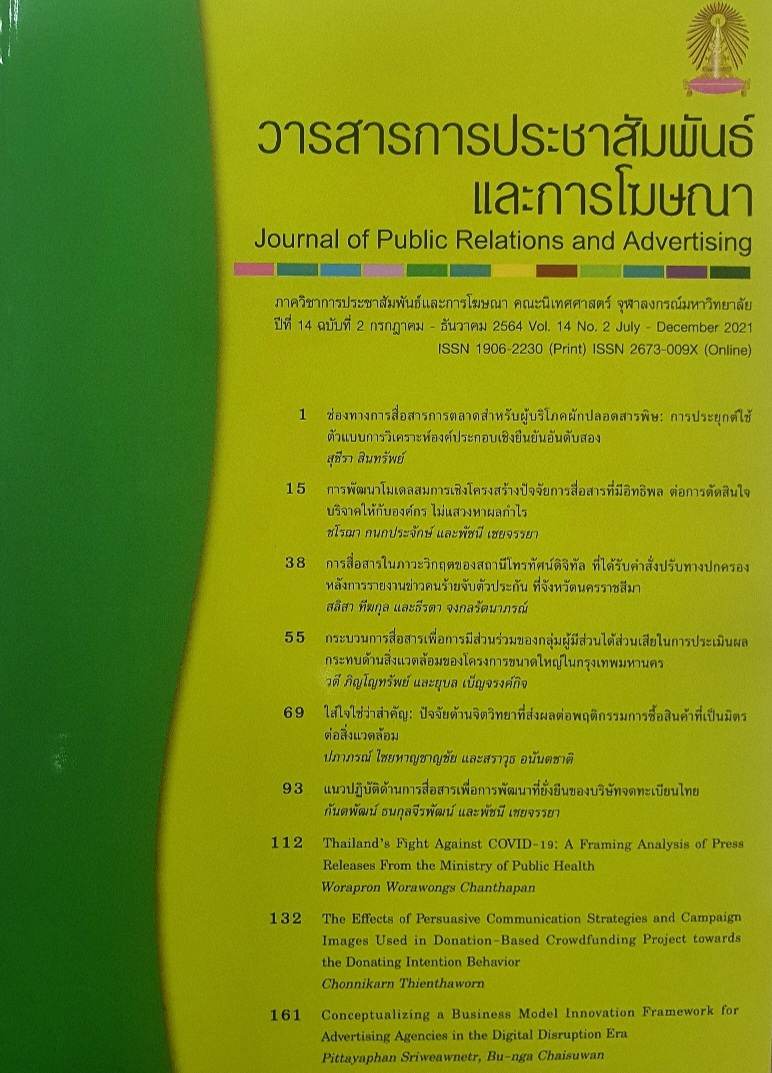The Participatory Communication Process of Stakeholders in the Environmental Impact Assessment of a Mega Project in Bangkok Metropolitan
Main Article Content
Abstract
The study was conducted by qualitative research through documentary analysis and in-depth interviews with stakeholders, supplemented by quantitative research through survey questionnaires. The research is aimed to 1) analyze and recommend an effective communication process in the EIA for a mega project in Bangkok, 2) analyze a communication process of the owner of the mega river project for establishing the stakeholders’ participation in playing their roles in the environmental impact assessment (EIA) process, and 3) analyze the use of new media in the EIA process. From the quantitative research, it was found that factors found to affect the effectiveness of participatory communication in the EIA were: 1) a two-way communication, 2) early starting with sufficient time of operations, 3) operations by experts, 4) the coverage of target groups, 5) proper patterns and methods of participation, 6) the use of proper communication media and channels, and 7) operations with sincerity. For the qualitative research, it was found that the owner of the mega river project operated by only two factors: two-way communication and the use of proper patterns and methods for creating a participatory process. Accordingly, the outcome of a participatory process was perceived at a low level. Namely, the stakeholders participated in the project in the stage of receiving information only without an opinion exchange process nor a collaborative determination of related measures. Besides, the project owner did not use new media, as widely used by general people, to create understanding; thus, the stakeholders could not receive information sufficiently.
Article Details
References
กระทรวงเทคโนโลยีสารสนเทศและการสื่อสาร. (2559). แผนพัฒนาดิจิทัลเพื่อเศรษฐกิจและสังคม. วันที่เข้าถึงข้อมูล 26มิถุนายน 2563 แหล่งที่มา https://www.netpracharat.com/Documents/แผนพัฒนาดิจิทัลเพื่อเศรษฐกิจและสังคม.pdf
กระทรวงทรัพยากรธรรมชาติและสิ่งแวดล้อม. (2562). ประกาศกระทรวงทรัพยากรธรรมชาติและสิ่งแวดล้อม เรื่องกำหนดโครงการ กิจการ หรือการดำเนินการ ซึ่งต้องจัดทำรายงานการประเมินผลกระทบสิ่งแวดล้อม และหลักเกณฑ์ วิธีการ และเงื่อนไขในการจัดทำรายงานการประเมินผลกระทบสิ่งแวดล้อม. วันที่เข้าถึงข้อมูล 26 มิถุนายน 2563 แหล่งที่มา http://www.onep.go.th/eia/wp-content/uploads/2019/01/EIA040162.pdf
กนกพร สว่างแจ้ง. (2549). ขั้นตอนการประเมินผลกระทบสิ่งแวดล้อม EIA พิมพ์ครั้งที่ 2. นครปฐม: โรงพิมพ์มหาวิทยาลัยศิลปากร.
กาญจนา แก้วเทพ. (2545). สื่อสารมวลชน:ทฤษฎีและแนวทางการศึกษา พิมพ์ครั้งที่ 3. กรุงเทพมหานคร: บริษัทโรงพิมพ์ศาลาแดง จำกัด.
กาญจนา แก้วเทพ. (2549). สื่อสารเพื่อโลกสวย บทเรียนจากการสื่อสารเพื่อการจัดการสิ่งแวดล้อมในชุมชน. กรุงเทพมหานคร: เซเว่น พริ้นติ้ง กรุ๊ป.
กาญจนา แก้วเทพ และ นิคม ชัยขุนพล. (2556). คู่มือสื่อใหม่ศึกษา. กรุงเทพมหานคร: ภาพพิมพ์.
กาญจนา แก้วเทพ และ สุมสุข หินวิมาน. (2553). สายธารแห่งนักคิดทฤษฎีเศรษฐศาสตร์การเมืองกับการสื่อสารศึกษา. กรุงเทพมหานคร: ภาพพิมพ์.
กานต์ ทัศนภักดิ์. (2555). สื่อใหม่กับการเคลื่อนไหวทางการเมือง. เชียงใหม่: ศุภนิตย์การพิมพ์
คนางค์ คันธมธุรพจน์. (2561). การมีส่วนร่วมของประชาชนในการประเมินผลกระทบสิ่งแวดล้อม.กรุงเทพมหานคร: แดแน็กซ์ อินเตอร์คอร์ปเรชั่น จำกัด.
คำสั่งโครงการพัมนาริมฝั่งแม่น้ำเจ้าพระยา. (กุมภาพันธ์ 2563). ข่าวศาลปกครอง, (7/2563). วันที่เข้าถึงข้อมูล 8 พฤศจิกายน 2563 แหล่งที่มา https://admincourt.go.th/admincourt/site/08hotsuit_detail.php?ids=19263
ชุติสันต์ เกิดวิบูลย์เวช. (2559). สื่อดิจิทัลใหม่ สื่อแห่งอนาคต. กรุงเทพมหานคร: สำนักพิมพ์สถาบันบัณฑิตพัฒนบริหารศาสตร์.
ไชยรัตน์ เจริญสินโอฬาร. (2540). ขบวนการเคลื่อนไหวทางสังคมรูปแบบใหม่. กรุงเทพมหานคร: สำนักพิมพ์วิภาษา.
ประภาส ปิ่นตบแต่ง. (2556). ขบวนการทางสังคมใหม่ (New Social Movement – NSM). วันที่เข้าถึงข้อมูล 1 กันยายน 2563 แหล่งที่มา https://www.imageplus.co.th/content-detail.php?id=77
ปาริชาติ สถาปิตานนท์. (2551). การสื่อสารประเด็นสาธารณะและการเปลี่ยนแปลงในสังคมไทย. กรุงเทพมหานคร: สำนักพิมพ์แห่งจุฬาลงกรณ์มหาวิทยาลัย.
พวงพนา คุณวัฒน์. (2545). กระบวนการสื่อสารสาธารณะของกลุ่มชาวบ้านผู้คัดค้านเขื่อนปากมูล (วิทยานิพนธ์ปริญญามหาบัณฑิต). กรุงเทพมหานคร: จุฬาลงกรณ์มหาวิทยาลัย
ลดาพรรณ สิงคิบุตร. (2557). การสื่อสารการเคลื่อนไหวคัดค้านการสร้างเขื่อนแม่วงก์ผ่านเฟซบุ๊ก SASIN CHALENRMLARP(วิทยานิพนธ์ปริญญามหาบัญฑิต). กรุงเทพมหานคร: จุฬาลงกรณ์มหาวิทยาลัย.
สำนักงานพัฒนาธุรกรรมทางอิเล็กทรอนิกส์. (2563). ETDA เผยปี 62 คนไทยใช้อินเทอร์เน็ตเพิ่มขึ้นเฉลี่ย 10 ชั่วโมง 22 นาที Gen Y ครองแชมป์ 5 ปีซ้อน. (ข่าวประชาสัมพันธ์). วันที่เข้าถึงข้อมูล 30 พฤศจิกายน 2563 แหล่งที่มา https://www.etda.or.th/th/NEWS/ETDA-Revealed-Thailand-Internet-User-Behavior-2019.aspx
สำนักนโยบายและแผนทรัพยากรธรรมชาติและสิ่งแวดล้อม. (2562). การประเมินผลกระทบสิ่งแวดล้อม. วันที่เข้าถึงข้อมูล 30 พฤศจิกายน 2563 แหล่งที่มา https://www.onep.go.th/การประเมินผลกระทบสิ่งแ/
อัศวิน เนตรโพธิ์แก้ว. (2557). นวัตกรรมสื่อสังคมกับประชาคมอคติ. วารสารนิเทศศาสตร์และนวัตกรรม สถาบันบัณฑิตพัฒนบริหารศาสตร์, 1(1), 19-32.
Arnstein, S.R. (1969). A Ladder Of Citizen Participation. Journal of the American Institute of Planners, 35(4), 216-224. DOI no.: 10.1080/01944366908977225
Jones, L., & Wells, K. (2007). Strategies for academic and clinician engagement in community-participatory partnered research. Jama, 297(4), 407-410.
Mostert, E. (2003). The challenge of public participation. Water Policy, 5(2), 179-197.
Rogers, E. M. (1962). The Diffusion of Innovations, Glencoe II: Free Press
Rowe Gene and Frewer, Lynn J. (2000). Public participation methods; a framework for evaluation. Safe Journal. 25, 3-29.
White, S. A., Nair, K. S., & Ascroft, J. (1994). Participatory communication: Working for change and development. New Delhi: Sage.
Siapera, E. (2018). Understanding New Media 2nd Edition. London: SAGE Publications.


